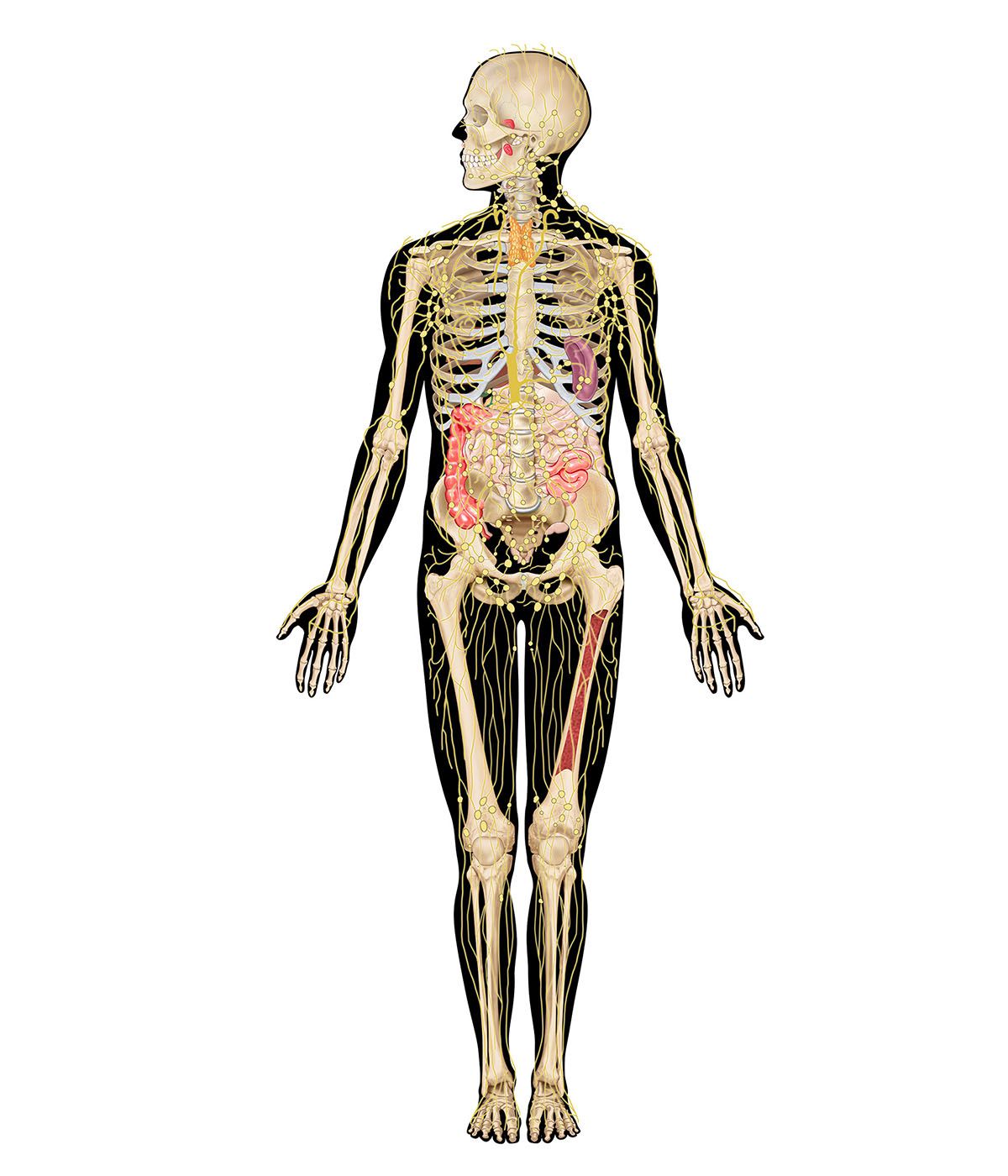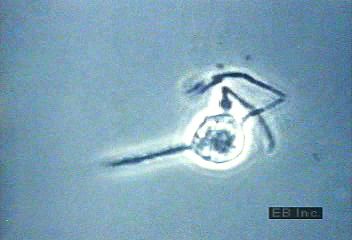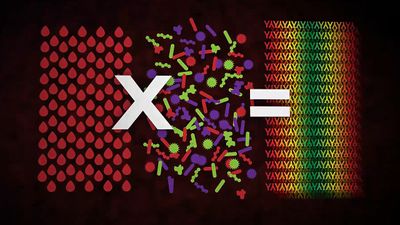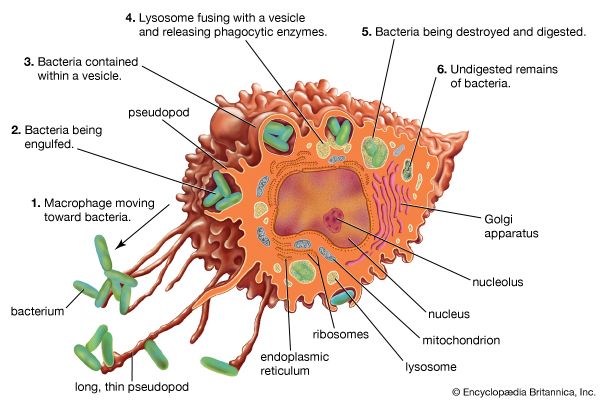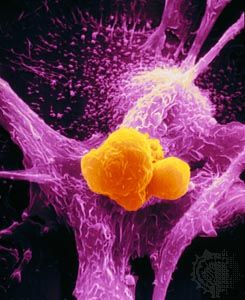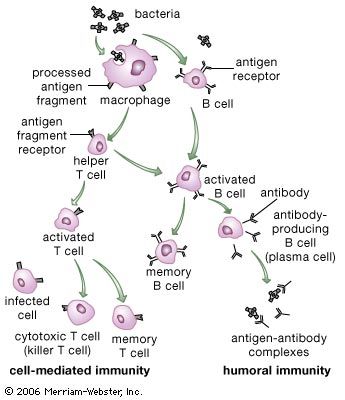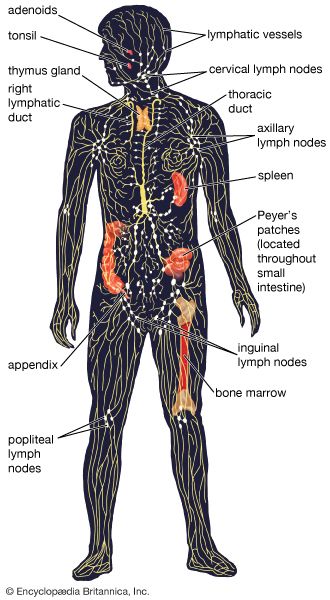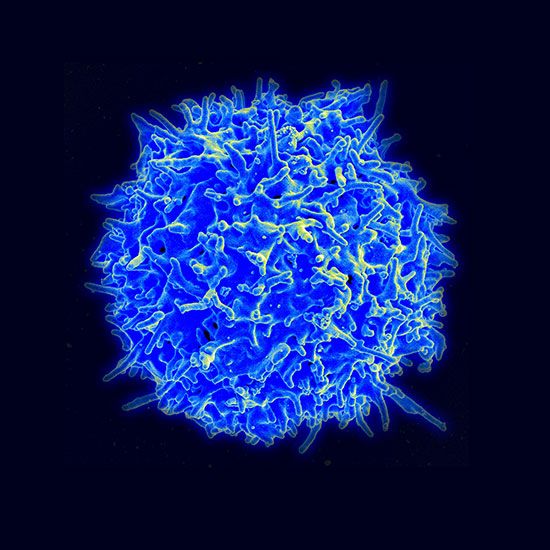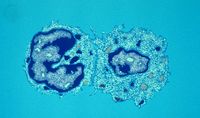Activation of killer cells
Some cells that bear antigen-antibody complexes do not attract complement; their antibody molecules are far apart on the cell surface or are of a class that does not readily activate the complement system (e.g., IgA, IgD, and IgE). Other cells have outer membranes that are so tough or can be repaired so quickly that the cells are impermeable to activated complement. Still others are so large that phagocytes cannot ingest them. Such cells, however, can be attacked by killer cells present in the blood and lymphoid tissues. Killer cells, which may be either cytotoxic T cells or natural killer cells, have receptors that bind to the tail portion of the IgG antibody molecule (the part that does not bind to antigen). Once bound, killer cells insert a protein called perforin into the target cell, causing it to swell and burst. Killer cells do not harm bacteria, but they play a role in destroying body cells infected by viruses and some parasites.
Other antibody-mediated mechanisms
The protection conferred by IgA antibodies, which are transported to the surface of mucous-membrane-lined passages, is somewhat different. Complement activation is not involved; there are no complement proteins in the lining of the gut or the respiratory tract. Here the available immune defense mechanism is primarily the action of IgA combining with microbes to prevent them from entering the cells of the lining. The bound microbes are then swept out of the body. IgA also appears to direct certain types of cell-mediated killing.
IgE antibodies also invoke unique mechanisms. As stated earlier, most IgE molecules are bound to special receptors on mast cells and basophils. When antigens bind to IgE antibodies on these cells, the interaction does not cause ingestion of the antigens but rather triggers the release of pharmacologically active chemical contents of the cells’ granules. The chemicals released cause a sudden increase in permeability of the local blood vessels, the adhesion and activation of platelets (blood cell fragments that trigger clotting), which release their own active agents, the contraction of smooth muscle in the gut or in the respiratory tubes, and the secretion of fluids—all of which tend to dislodge large multicellular parasites such as hookworms. Eosinophil granulocytes and IgE together are particularly effective at destroying parasites such as the flatworms that cause schistosomiasis. The eosinophils plaster themselves to the worms bound to IgE and release chemicals from their granules that break down the parasite’s tough protective skin. Therefore, IgE antibodies—although they can be a nuisance when they react with otherwise harmless antigens—appear to have a special protective role against the larger parasites.
Transfer of antibodies from mother to offspring
A newborn mammal has no opportunity to develop protective antibodies on its own, unless, as happens very rarely, it was infected while in the uterus. Yet it is born into an environment similar to its mother’s, which contains all the potential microbial invaders to which she is exposed. Although the fetus possesses the components of innate immunity, it has few or none of its mother’s lymphocytes. The placenta generally prevents the maternal lymphocytes from crossing into the uterus, where they would recognize the fetal tissues as foreign antigens and cause a reaction similar to the rejection of an incompatible organ transplant.
What is transferred across the placenta in many species is a fair sample of the mother’s antibodies. How this happens depends on the structure of the placenta, which varies among species. In humans maternal IgG antibodies—but not those of the other immunoglobulin classes—are transported across the placenta into the fetal bloodstream throughout the second two-thirds of pregnancy. In many rodents a similar transfer occurs, but primarily across the yolk sac.
In horses and cattle, which have more layers of cells in their placentas, no antibodies are transferred during fetal life, and the newborn arrives into the world with no components of specific immunity. There is, however, a second mechanism that makes up for this deficiency. The early milk (colostrum) is very rich in antibodies—mainly IgA but also some IgM and IgG—and during the first few days of life the newborn mammal can absorb these proteins intact from the digestive tract directly into the bloodstream. Drinking colostrum is therefore essential for newborn horses and cattle and required to a somewhat lesser extent by other mammals. The capacity of the digestive tract to absorb intact proteins must not last beyond one or two weeks, since once foods other than milk are ingested, the proteins and other antigens in them would also be absorbed intact and could act as immunogens to which the growing animal would become allergic (see immune system disorder: Allergies). IgA in milk is, however, rather resistant to digestion and can function within the gut even after intact absorption into the bloodstream has ended. Human colostrum is also rich in IgA, with the concentration highest immediately after birth.
After a newborn has received its supply of maternal antibodies, it is as fully protected as its mother. This means, of course, that if the mother has not developed immunity to a particular pathogen, the newborn will likewise be unprotected. For this reason, a physician may recommend that a prospective mother receive immunizations against tetanus and certain other disorders. (The active immunization of pregnant women against certain viral diseases, such as rubella [German measles], must be avoided, however, because the immunizing agent can cross the placenta and produce severe fetal complications.)
As important as the passively transferred maternal antibodies are, their effects are only temporary. The maternal antibodies in the blood become diluted as the animal grows; moreover, they gradually succumb to normal metabolic breakdown. Because the active development of acquired immunity is a slow and gradual process, young mammals actually become more susceptible to infection during their early stages of growth than they are immediately after birth.
Occasionally the transfer of maternal antibodies during fetal life can have harmful consequences. A well-known example of this is erythroblastosis fetalis, or hemolytic disease of the newborn, a disorder in which maternal antibodies destroy the child’s red blood cells during late pregnancy and shortly after birth. The most severe form of erythroblastosis fetalis is Rh hemolytic disease, which develops when:
- The mother is Rh-negative, which is to say her red blood cells lack the Rh factor.
- The mother’s immune system has been previously activated against the Rh antigen; this usually is the result of exposure to fetal cells during the birth of an earlier Rh-positive baby or a transfusion of Rh-positive blood.
Rh hemolytic disease can be prevented by giving the mother injections of anti-Rh antibody shortly after the birth of an Rh-positive child. This antibody destroys any Rh-positive fetal cells in the maternal circulation, thereby preventing the activation of the mother’s immune system should she conceive another Rh-positive fetus.
Cell-mediated immune mechanisms
In addition to their importance in cooperating with B cells that secrete specific antibodies, T cells have important, separate roles in protecting against antigens that have escaped or bypassed antibody defenses. Immunologists have long recognized that antibodies do not necessarily protect against viral infections, because many viruses can spread directly from cell to cell and thus avoid encountering antibodies in the bloodstream. It is also known that persons who fail to make antibodies are very susceptible to bacterial infections but are not unduly liable to viral infections. Protection in these cases results from cell-mediated immunity, which destroys and disposes of body cells in which viruses or other intracellular parasites (such as the bacteria that cause tuberculosis and leprosy) are actively growing, thus depriving microorganisms of their place to grow and exposing them to antibodies.
As discussed in the section Activation of T and B lymphocytes, cell-mediated immunity has two mechanisms. One involves activated helper T cells, which release cytokines. In particular, the gamma interferon produced by helper T cells greatly increases the ability of macrophages to kill ingested microbes; this can tip the balance against microbes that otherwise resist killing. Gamma interferon also stimulates natural killer cells. The second mechanism of cell-mediated immunity involves cytotoxic T cells. They attach themselves by their receptors to target cells whose surface expresses appropriate antigens (notably ones made by developing viruses) and damage the infected cells enough to kill them.
Cytotoxic T cells may kill infected cells in a number of ways. The mechanism of killing used by a given cytotoxic T cell depends mainly on a number of costimulatory signals. In short, cytotoxic T cells can kill their target cells either through the use of pore-forming molecules, such as perforins and various components of cytoplasmic granules, or by triggering a series of events with the target cell that activate a cell death program, a process called apoptosis. In general, the granular cytotoxic T cells tend to kill cells directly by releasing the potent contents of their cytotoxic granules at the site of cell-to-cell contact. This renders the cell membrane of the target cell permeable, which allows the cellular contents to leak out and the cell to die. The nongranular cytotoxic T cells often kill cells by inducing apoptosis, usually through the activation of a cell-surface protein called Fas. When a protein on the surface of the cytotoxic T cell interacts with the Fas protein on the target cell, Fas is activated and sends a signal to the nucleus of the target cell, thus initiating the cell death process. The target cell essentially commits suicide, thereby destroying the virus within the cell as well.


